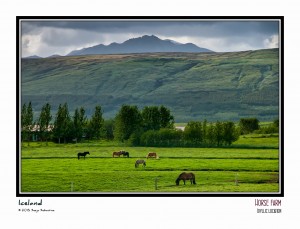
We spent two days (and two nights) in Iceland on a stop-over while returning from France to the United States. We were flying Iceland Air (highly recommended: wonderful staff) and as they don’t charge a premium for a break journey, we decided to take advantage of the situation. The flight from Paris landed at around 10 am on rainy morning in late June and after getting our rental car & a quick lunch stop, we were out of Keflavik airport and on our way to Thingvellr National Park.
Within minutes of leaving the airport town of Keflavik, we were already marveling at the beautiful and pristine landscape that seemed miles away from any civilization. All along the way to Thingvellr there were no houses and no discernible signs of a township or settlement. Fields of purple lupines stretched all the way to the green mountains in the distance. Waterfalls were abundant. Majestic Icelandic horses dotted the landscape and in between them we could see sheep grazing in the pasture. Later we were told that the horses didn’t outnumber humans in Icelend but I am not sure that I believe it!!
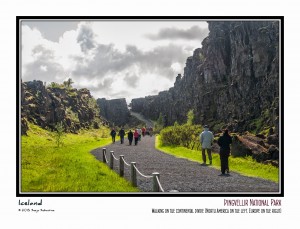 The scarcity of people was especially noticeable at the Thingvellr NP.  This place is the central gathering place for major national events: such as flag hoisting for the National Day – the Icelandic equivalent of Red Fort in India or the National Mall in Washington DC. And it was empty. For miles around the park, there were hardly any sign of habitation. No shops. No vendors selling candy or cheesy souviners.  No signs of nearby human life except the few tourists walking about.  Although Thingvellr has historic importance to the people of Iceland (several major historic events that defined the creation of Iceland took place here), the fact that put this place on our must-see list was the fact that this is the site of a continental divide—the place where the two tectonic plates of Europe and North America meet. And we could actually walk in between these two plates – a very surreal experience
The scarcity of people was especially noticeable at the Thingvellr NP.  This place is the central gathering place for major national events: such as flag hoisting for the National Day – the Icelandic equivalent of Red Fort in India or the National Mall in Washington DC. And it was empty. For miles around the park, there were hardly any sign of habitation. No shops. No vendors selling candy or cheesy souviners.  No signs of nearby human life except the few tourists walking about.  Although Thingvellr has historic importance to the people of Iceland (several major historic events that defined the creation of Iceland took place here), the fact that put this place on our must-see list was the fact that this is the site of a continental divide—the place where the two tectonic plates of Europe and North America meet. And we could actually walk in between these two plates – a very surreal experience
The next stop on our tour was the waterfalls of Gullifoss. Gullifoss, Thingvellr and Geysir make up Iceland’s golden triangle : most visited tourist destinations. Gullifoss is a two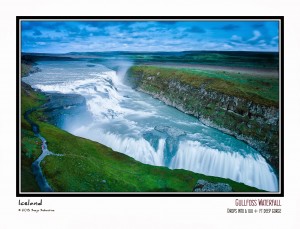 layer waterfall and was quite beautiful with twin rainbows over the cascading water.  After viewing Gullifoss and having the much recommended lamb stew from the rest area (warm stew on a rainy day– can’t beat that!), we set out to visit the geothermal area of Geysir. This place is the first recorded mention of the geysers and the very word is derived from this place. While the main Geysir doesn’t erupt any more, the Stokker Geysir entertained us by erupting every 3-4 minutes.
layer waterfall and was quite beautiful with twin rainbows over the cascading water.  After viewing Gullifoss and having the much recommended lamb stew from the rest area (warm stew on a rainy day– can’t beat that!), we set out to visit the geothermal area of Geysir. This place is the first recorded mention of the geysers and the very word is derived from this place. While the main Geysir doesn’t erupt any more, the Stokker Geysir entertained us by erupting every 3-4 minutes.
Our progress was slow because we kept stopping to admire and photograph the scenery throughout the drive. The weather was unusually chilly for summer. Despite its name Iceland actually doesn’t have icy weather all through the year. The coastal areas have temperatures of 30F in winter . Interiors are colder. Summers were supposed to be a doable 50-55F but it was drizzling constantly when we were there and so the weather was quite chilly. This was a mixed blessing for had if the weather was perfect, I am sure we wouldn’t have made it beyond the first few spots. The chilly weather ensured that we got into the car and pushed on towards the next place.
We were staying for two nights  at Hotel Laekur , a very cosy B&B and horse farm  about two hours away from Reykjavik , closer to the Southern town of Vik. We were welcomed warmly and showed to our little room—with a crib for Annika that she did never use. The family that runs the hotel was wonderful and even warmed some milk for Annika although it was past 11 pm when we reached. It was still fairly bright outside and our host told us that it would be this bright till around 3 am when the sun came up!
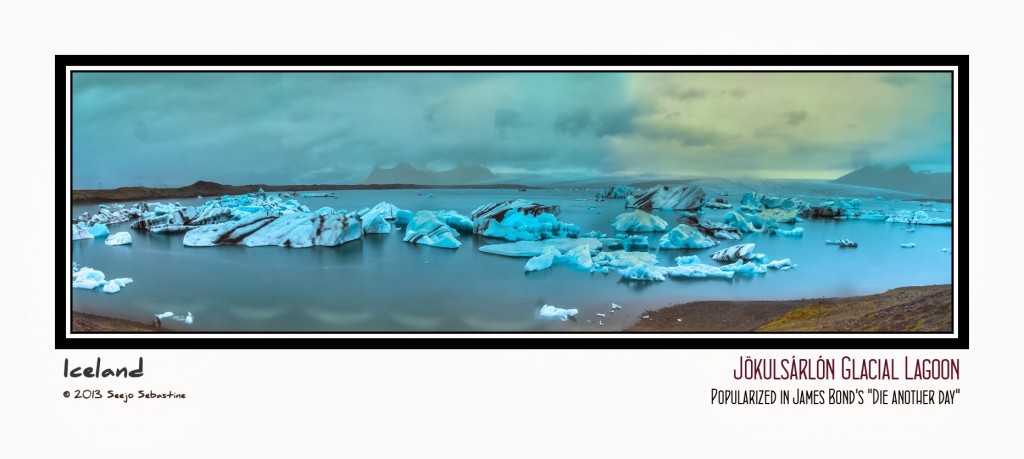
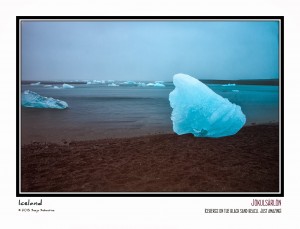 The next morning after a wonderful breakfast of eggs, pancakes (with some yummy fruity syrup) and Iceland’s famous yoghurt or Skyr, we started on our long drive to  Jokulsarlon and the Vatnajökull National Park. Vatanajokull is the largest glacier in Europe and covers  almost 8% of Iceland. Jokulsarlon is a glacial lagoon or glacial lake in Vatanajokul National Park and has been the location for some famous movies including the Bond movie, Die Another Day. The icebergs that calve from the glacier fall into the glacier lake and float gently onto the black sand beach at the edge of the lagoon. It is rather bizarre to see ice chunks on a beach rather than driftwood.  But the juxtaposition of the blue ice structures melting on the black sand provides an astonishing view. There was a tiny hillock that we could climb to get panoramic views of the glaciers: large boulders of bright blue ice floating down the river.
The next morning after a wonderful breakfast of eggs, pancakes (with some yummy fruity syrup) and Iceland’s famous yoghurt or Skyr, we started on our long drive to  Jokulsarlon and the Vatnajökull National Park. Vatanajokull is the largest glacier in Europe and covers  almost 8% of Iceland. Jokulsarlon is a glacial lagoon or glacial lake in Vatanajokul National Park and has been the location for some famous movies including the Bond movie, Die Another Day. The icebergs that calve from the glacier fall into the glacier lake and float gently onto the black sand beach at the edge of the lagoon. It is rather bizarre to see ice chunks on a beach rather than driftwood.  But the juxtaposition of the blue ice structures melting on the black sand provides an astonishing view. There was a tiny hillock that we could climb to get panoramic views of the glaciers: large boulders of bright blue ice floating down the river.
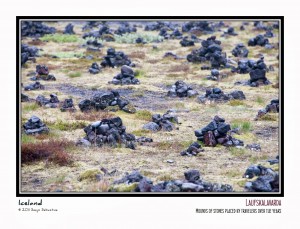 After Seejo finished taking a few photographs, we turned our way back. We had driven non-stop on the way here and the plan was to have lots of stops along the way back. We enjoyed the
After Seejo finished taking a few photographs, we turned our way back. We had driven non-stop on the way here and the plan was to have lots of stops along the way back. We enjoyed the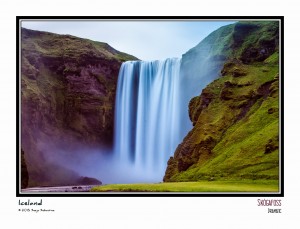 rapidly changing landscape as we drove down Route 1.  Iceland has only one major road..Route 1 or Ring Road- it is around the perimeter of the country and connects the major towns – all of which are located on the coast. The view of the black volcanic soil and the magnificent glaciers gave way to a rocky landscape filled with stacked stones. At first we thought that these were natural structures but then realized that these “cairns†or stacks were created when passing travelers added a stone to the cairn for good luck.  The sight of the cairns soon gave way to green picturesque valleys with horse farms and the occasional Icelandic Turf House (a house which is built to be part of the landscape – the roof
rapidly changing landscape as we drove down Route 1.  Iceland has only one major road..Route 1 or Ring Road- it is around the perimeter of the country and connects the major towns – all of which are located on the coast. The view of the black volcanic soil and the magnificent glaciers gave way to a rocky landscape filled with stacked stones. At first we thought that these were natural structures but then realized that these “cairns†or stacks were created when passing travelers added a stone to the cairn for good luck.  The sight of the cairns soon gave way to green picturesque valleys with horse farms and the occasional Icelandic Turf House (a house which is built to be part of the landscape – the roof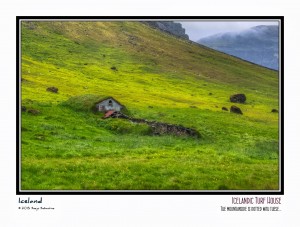 in covered with grass.).  Waterfalls were abundant, we could see one every couple of miles. We stopped briefly at the Skogafoss and Seljalandfoss waterfalls.  We liked the Skogafoss waterfall because the water flowed down in the  rumbling stream down a grassy meadow where cows and sheeps were grazing. Annika was mesmerized by the cows and wanted to cross the stream to get to the cows.  The other sights on our way back included the site of  the Eyjafjallajökullvolcano which recently erupted in 2010, the beaches at Vik and a brief shopping stop to buy some of the famous Icelandic wool products.
in covered with grass.).  Waterfalls were abundant, we could see one every couple of miles. We stopped briefly at the Skogafoss and Seljalandfoss waterfalls.  We liked the Skogafoss waterfall because the water flowed down in the  rumbling stream down a grassy meadow where cows and sheeps were grazing. Annika was mesmerized by the cows and wanted to cross the stream to get to the cows.  The other sights on our way back included the site of  the Eyjafjallajökullvolcano which recently erupted in 2010, the beaches at Vik and a brief shopping stop to buy some of the famous Icelandic wool products.
We passed the town of Vik which consisted of a gas station, a grocery store , a church and a dispensary and a few scattered houses. While doing our research on Iceland, we had learnt that Vik is one the largest towns in southern Iceland. Seeing the size of the town (about half a dozen houses with one grocery store!) really drove the point home that Iceland was quite sparsely populated.   We stopped for dinner at the Hotel Ranga (good food, absolutely friendly servers, gracious owner but pricey food). We had read that food in Iceland is expensive and that turned out to be true. Till some years ago, fresh fruit was typically a Christmas treat – not surprising when I saw how exorbitant the cost of fresh food was.
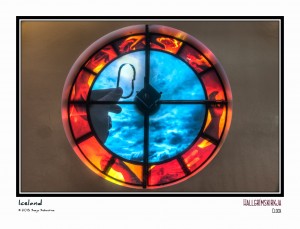 The next day we went to the capital city of Reykjavik. Our first stop was the famous church at HallgrÃmskirkja—one the tallest churches in the world. The most intriguing
The next day we went to the capital city of Reykjavik. Our first stop was the famous church at HallgrÃmskirkja—one the tallest churches in the world. The most intriguing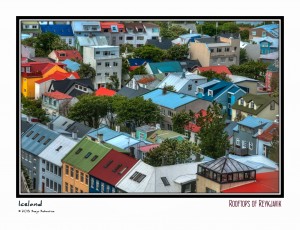 feature of this church to me were the huge stained glass style windows in the observation tower Unlike other churches where these features saints or other religious events, the windows depicted ordinary items that reflected life in Iceland. From the observation tower at the top of the church, one can get a lovely view of the colorful  rooftops of the city of Reykjavik and the surrounding sea.
feature of this church to me were the huge stained glass style windows in the observation tower Unlike other churches where these features saints or other religious events, the windows depicted ordinary items that reflected life in Iceland. From the observation tower at the top of the church, one can get a lovely view of the colorful  rooftops of the city of Reykjavik and the surrounding sea.
After a quick lunch (hot dogs), we were off on our way to Keflavik airport to return to the United States. Two and half days were just enough to get the feel for the country and a quick glimpse of the highlights. We definitely want to come back. Hopefully in winter to enjoy the Northern lights!
Some other weird facts about Iceland:
1.      There are no trains in the country!
2.      People have names with suffixes  like Jonasson and Jonasdottir. So the last name of Mr. Jonas’s son and daughter would be Jonasson and Jonasdottir respectively.
3. Icleand has a gay /lesbian Prime Minister and nobody in Iceland seems to think it is a big deal. Very tolerant society.
4.      The national past time seems to be knitting. The most famous sweaters or the lopapeysa (pullovers with design at the neck) are everywhere but very very expensive.
5.      Despite its name Iceland is not that cold. It is at the same latitude as Boston and thanks to the Gulf Stream the coasts have warm weather. The interior gets colder and only  11% of country has glaciers. Unfortunately when we visited it was rainy and chilly (very unusual summer according to the locals) so we really couldn’t say if the weather is warm!
7.    Most students go abroad (mainland Europe) to study if they want to specialize in any particular technical field say medicine or architecture.
8. Probably one of the only countries where we did not see a single Indian family .
9. Icelandic history is chronicled in the form of Icelandic sagas. These are stories set in the thirteenth and fourteenth centuries and tell tales of important events and people in Iceland’s history.
10. According to our B&B host, it was quite common for the Icelanders to go to Europe during the winter. Spain seemed to be a very popular destination for them.
11. There were hardly any trees in Iceland. Apparently when the Vikings settled trees were abundant but were soon cut down while building the settlement.
